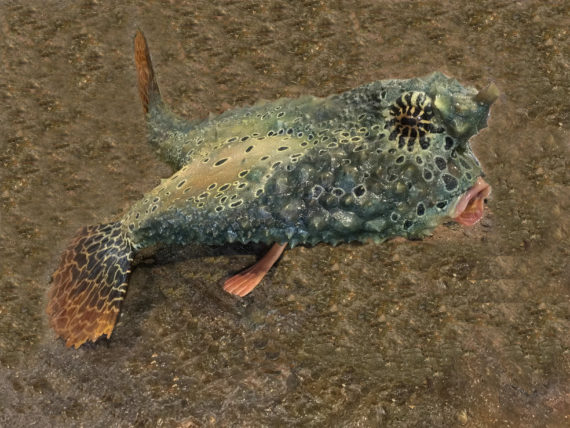Polka-dot Batfish, Ogcocephalus cubifrons
 Polka-dot Batfish, Ogcocephalus cubifrons. The mascot of the Rookery Bay National Estuarine Research Reserve, Naples, Florida, that is a cement statue approximately one and half meters (5 feet) in length and 10X greater than normal size of the fish. Note that the fish has two tails!
Polka-dot Batfish, Ogcocephalus cubifrons. The mascot of the Rookery Bay National Estuarine Research Reserve, Naples, Florida, that is a cement statue approximately one and half meters (5 feet) in length and 10X greater than normal size of the fish. Note that the fish has two tails!
The Polka-dot Batfish, Ogcocephalus cubifrons, is a member of the Batfish or Ogcocephalidae Family, and is known in Mexico as murciélago diablo. Note: there is some confusion within the scientific literature related to this species as Ogcocephalus cubifrons and Ogcocephalus radiatus, being different or one and the same species. I have elected to utilize Ogcocephalus cubifrons noting that FishBase has both species with different range distributions and some scientific individual believe that radiatus is nomen dubium, and no longer valid. There are thirteen members of the Ogcocephalus Genus of which six are found in Mexican waters, all in the Atlantic Ocean.
The Polka-dot Batfish has an arrow-shaped flattened broad body that are shaped as rounded triangular disc that is wider at the front and tapers and flattens ventrally toward the tail. They vary in color with most being brown and covered with dark spots so of which are rimmed in white and patches of reddish and orange-brown dorsally. The pectoral fins are pale with a bright pattern of dark spots. Small fish have yellow caudal and pectoral fins with dark brown margins. Their caudal fin is thin and elongated, the pectoral fins are round and are supported by arm-like stalks under the body that are inserted behind the pelvic fins. Their head is large, elevated and bony with a pointed snout, small mouth, small teeth, small gill openings with a unique unicorn-like shaped rostrum between the eyes that is longer in juveniles than in adults; and the dorsal fin has one spine located underneath the rostrum that is movable and acts as a lure to attract prey within striking distance. The anal fin is small and fleshy. They lack scales and the skin is rough with bony wart-like tubercles, on the dorsal surface.
The Polka-dot Batfish is a demersal species that resides over sand and muddy bottoms, coral rubble or seagrass meadows that can be found at depths up to 70 m (230 feet). They reach a maximum of 38.0 cm (15 inches) in length. They “walk” on the bottom in a side-to-side shuffling motion utilizing their pectoral and pelvic fins and are classic lie-in-wait-predators, being well camouflaged, that consume crabs, fish, mollusks, shrimps and worms. They use their wide flat body for defense and can lie on the floor bottom. Reproduction involves pelagic eggs and larvae that eventually settle to the bottom. The Polka-dot Batfish is poorly studied with very limited information available about their lifestyle and behavioral patterns including specific details on age, growth, longevity, movement patterns, diet, habitat use, and reproduction.
The Polka-dot Batfish is most likely confused with the Short-nose Batfish, Ogcocephalus nasutus (lack fin spots).
The Polka-dot Batfish is a resident of Mexican waters of the Atlantic Ocean but has a limited distribution being found only around the Yucatán Peninsula being most abundant on the Campeche Bank, Tabasco.
From a conservation perspective the Polka-dot Batfish is considered to be of Least Concern with stable widely distributed populations. They are of limited interest to most.